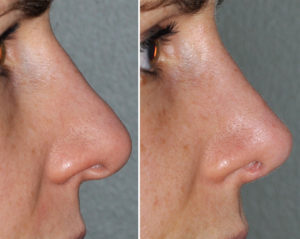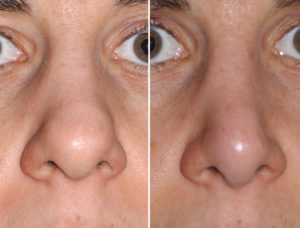Background: The shape of the nose is controlled completely by the shape of the osteocartilaginous framework underneath the skin. Nowhere on the nose is this more apparent than on the nasal tip. The complex scrolled shape of the lower alar cartilages and how they meet in the middle controls the shape of the lower third of the nose.
While the size of the lower alar cartilages controls how big the tip of the nose is, their symmetry influences how uniform it looks. Tip asymmetry is one of the most common aesthetic nasal deformities. It can be caused by a variety of anatomic derangements from a caudal septal deviation, buckling of the medial footplates, dome width asymmetry and alar length discrepancy to name a few.
While many rhinoplasty surgeries treat the whole nose, it is not always necessary. A tip rhinoplasty treats just the lower third of the nose and always involves some manipulation of the lower alar cartilages. Whether it is decreasing its size, changing its projection or degree of rotation, or just correcting asymmetry, the tip rhinoplasty leaves the bony structure of the nose alone. It a cartilaginous rhinoplasty as opposed to a more complete osteocartilaginous rhinoplasty.
Case Study: This young female was bothered by the shape of her nasal tip. It was bulbous as well as was asymmetric with a noticeable bump on the left side of the done. She was happy with her bridge and the nasal profile above the tip area.


Some nose reshaping procedures only need an isolated tip rhinoplasty. If the rest of the nasal profile and frontal shape of the bridge and middle vault is satisfactory then only tip work is necessary. Preoperative planning has to take into account on the patient’s profile what happens if tip deprojection is planned as this create a need to lower the entire profile up through the nasal bones.
Highlights:
- The cartilages of the nasal tip have the most complex anatomy of the nose.
- Nasal tip asymmetry occurs as a result of a discrepancy in the size or shape of the lower alar cartilages.
- An open rhinoplasty allows the best visual assessment and manipulation of nasal tip cartilages.
Dr. Barry Eppley
Indianapolis, Indiana


